Application of Holistic Approach in Treatment of Chronic Diseases
VerifiedAdded on 2023/06/04
|8
|2156
|482
AI Summary
This essay analyzes the application of various aspects of the holistic care theory to the case of a 40-year-old aboriginal woman suffering from diabetes. It discusses the importance of patient-centered care, family-centered care, and family networking care in achieving desired medical outcomes. The essay argues that the failure of nurses to apply holistic care approach led to the patient's suffering. The study suggests that every individual involved in the treatment of a patient should undertake their roles and communicate with both the family and the individual patient as well as other departments to avoid such cases.
Contribute Materials
Your contribution can guide someone’s learning journey. Share your
documents today.
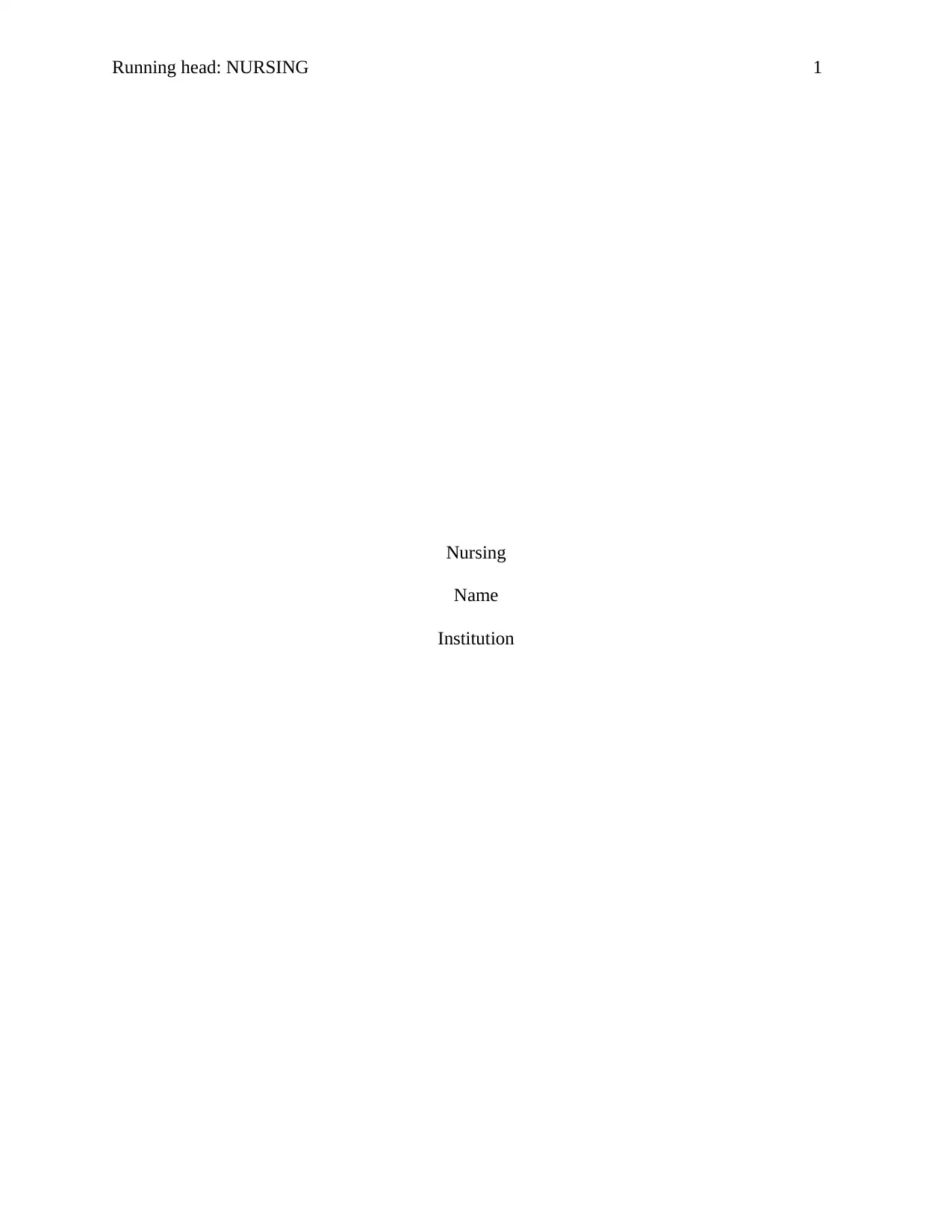
Running head: NURSING 1
Nursing
Name
Institution
Nursing
Name
Institution
Secure Best Marks with AI Grader
Need help grading? Try our AI Grader for instant feedback on your assignments.
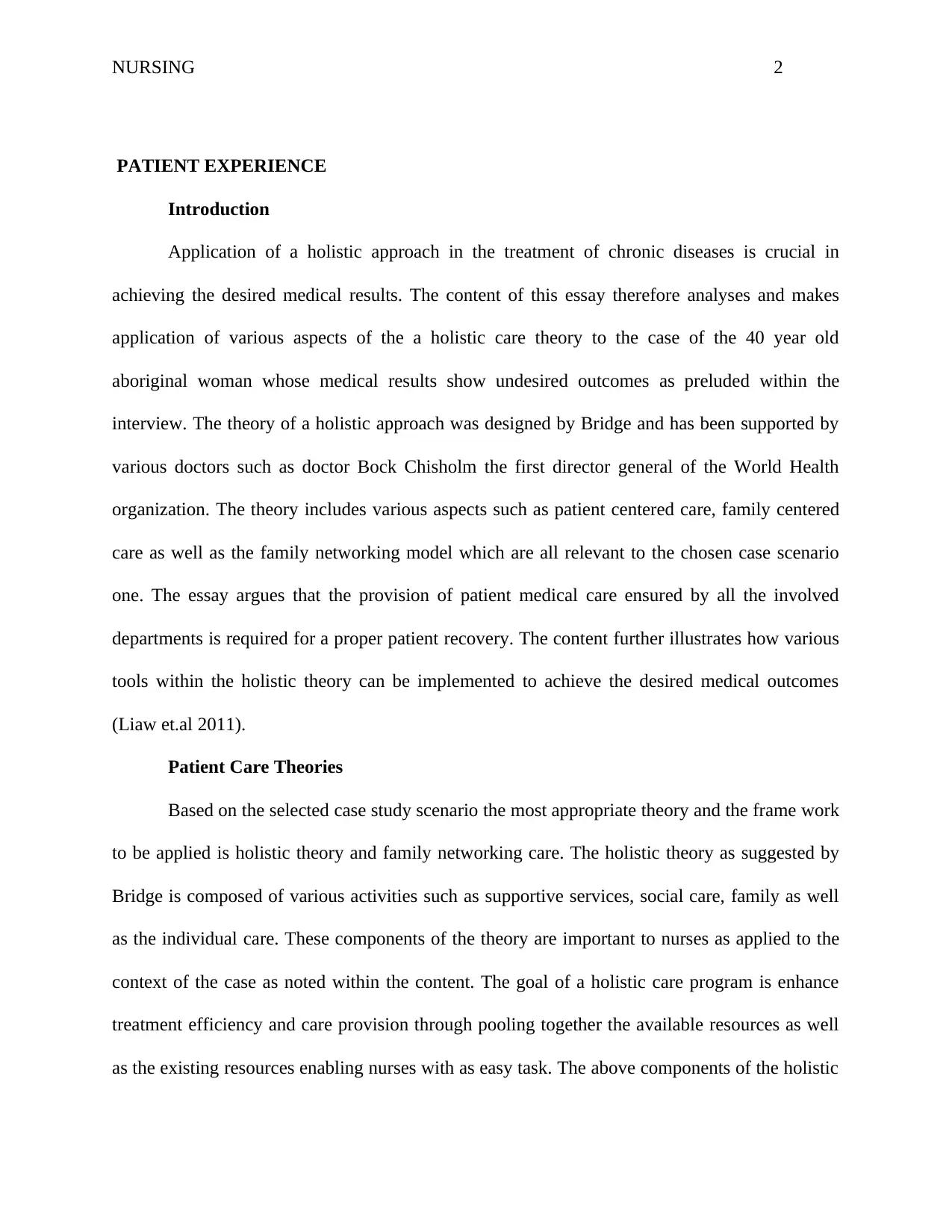
NURSING 2
PATIENT EXPERIENCE
Introduction
Application of a holistic approach in the treatment of chronic diseases is crucial in
achieving the desired medical results. The content of this essay therefore analyses and makes
application of various aspects of the a holistic care theory to the case of the 40 year old
aboriginal woman whose medical results show undesired outcomes as preluded within the
interview. The theory of a holistic approach was designed by Bridge and has been supported by
various doctors such as doctor Bock Chisholm the first director general of the World Health
organization. The theory includes various aspects such as patient centered care, family centered
care as well as the family networking model which are all relevant to the chosen case scenario
one. The essay argues that the provision of patient medical care ensured by all the involved
departments is required for a proper patient recovery. The content further illustrates how various
tools within the holistic theory can be implemented to achieve the desired medical outcomes
(Liaw et.al 2011).
Patient Care Theories
Based on the selected case study scenario the most appropriate theory and the frame work
to be applied is holistic theory and family networking care. The holistic theory as suggested by
Bridge is composed of various activities such as supportive services, social care, family as well
as the individual care. These components of the theory are important to nurses as applied to the
context of the case as noted within the content. The goal of a holistic care program is enhance
treatment efficiency and care provision through pooling together the available resources as well
as the existing resources enabling nurses with as easy task. The above components of the holistic
PATIENT EXPERIENCE
Introduction
Application of a holistic approach in the treatment of chronic diseases is crucial in
achieving the desired medical results. The content of this essay therefore analyses and makes
application of various aspects of the a holistic care theory to the case of the 40 year old
aboriginal woman whose medical results show undesired outcomes as preluded within the
interview. The theory of a holistic approach was designed by Bridge and has been supported by
various doctors such as doctor Bock Chisholm the first director general of the World Health
organization. The theory includes various aspects such as patient centered care, family centered
care as well as the family networking model which are all relevant to the chosen case scenario
one. The essay argues that the provision of patient medical care ensured by all the involved
departments is required for a proper patient recovery. The content further illustrates how various
tools within the holistic theory can be implemented to achieve the desired medical outcomes
(Liaw et.al 2011).
Patient Care Theories
Based on the selected case study scenario the most appropriate theory and the frame work
to be applied is holistic theory and family networking care. The holistic theory as suggested by
Bridge is composed of various activities such as supportive services, social care, family as well
as the individual care. These components of the theory are important to nurses as applied to the
context of the case as noted within the content. The goal of a holistic care program is enhance
treatment efficiency and care provision through pooling together the available resources as well
as the existing resources enabling nurses with as easy task. The above components of the holistic
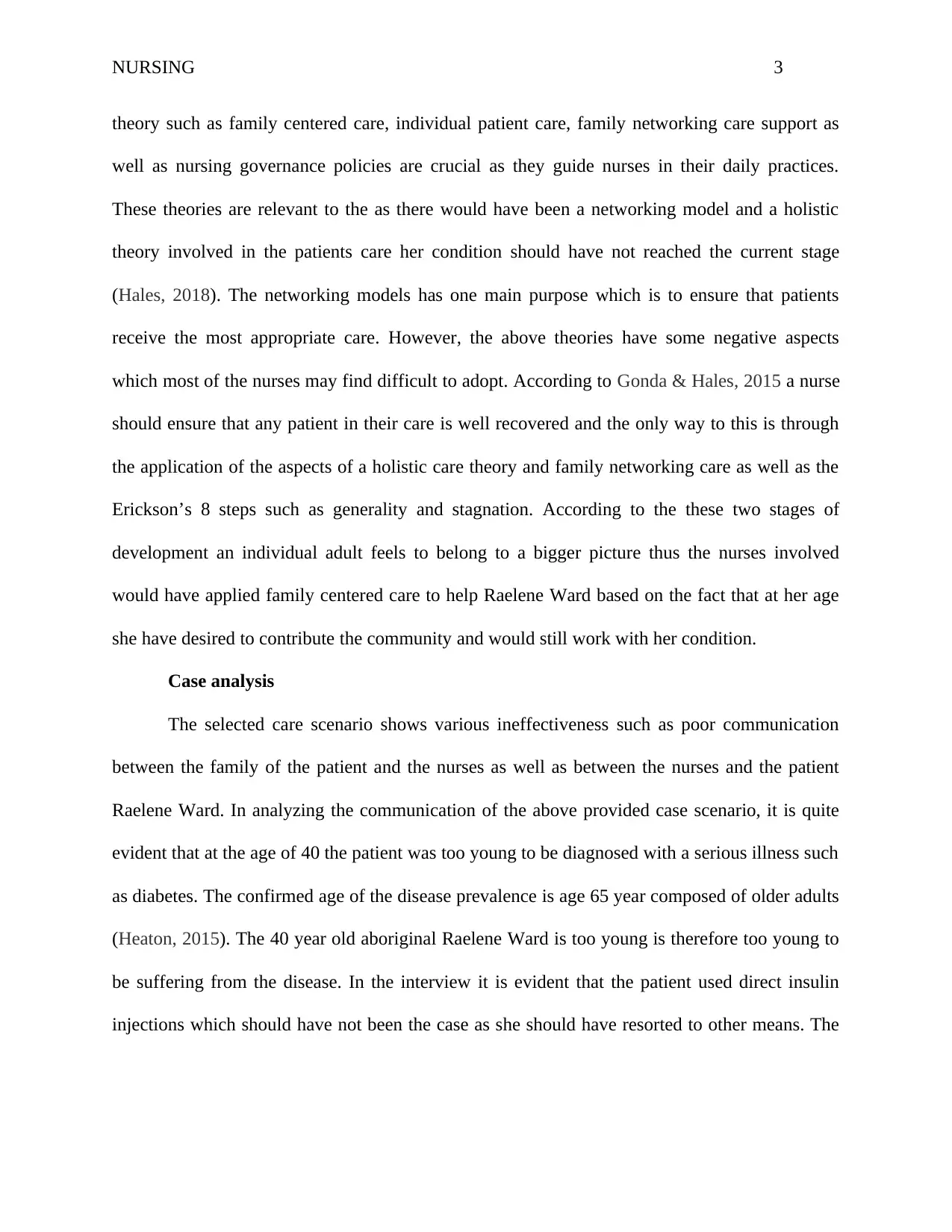
NURSING 3
theory such as family centered care, individual patient care, family networking care support as
well as nursing governance policies are crucial as they guide nurses in their daily practices.
These theories are relevant to the as there would have been a networking model and a holistic
theory involved in the patients care her condition should have not reached the current stage
(Hales, 2018). The networking models has one main purpose which is to ensure that patients
receive the most appropriate care. However, the above theories have some negative aspects
which most of the nurses may find difficult to adopt. According to Gonda & Hales, 2015 a nurse
should ensure that any patient in their care is well recovered and the only way to this is through
the application of the aspects of a holistic care theory and family networking care as well as the
Erickson’s 8 steps such as generality and stagnation. According to the these two stages of
development an individual adult feels to belong to a bigger picture thus the nurses involved
would have applied family centered care to help Raelene Ward based on the fact that at her age
she have desired to contribute the community and would still work with her condition.
Case analysis
The selected care scenario shows various ineffectiveness such as poor communication
between the family of the patient and the nurses as well as between the nurses and the patient
Raelene Ward. In analyzing the communication of the above provided case scenario, it is quite
evident that at the age of 40 the patient was too young to be diagnosed with a serious illness such
as diabetes. The confirmed age of the disease prevalence is age 65 year composed of older adults
(Heaton, 2015). The 40 year old aboriginal Raelene Ward is too young is therefore too young to
be suffering from the disease. In the interview it is evident that the patient used direct insulin
injections which should have not been the case as she should have resorted to other means. The
theory such as family centered care, individual patient care, family networking care support as
well as nursing governance policies are crucial as they guide nurses in their daily practices.
These theories are relevant to the as there would have been a networking model and a holistic
theory involved in the patients care her condition should have not reached the current stage
(Hales, 2018). The networking models has one main purpose which is to ensure that patients
receive the most appropriate care. However, the above theories have some negative aspects
which most of the nurses may find difficult to adopt. According to Gonda & Hales, 2015 a nurse
should ensure that any patient in their care is well recovered and the only way to this is through
the application of the aspects of a holistic care theory and family networking care as well as the
Erickson’s 8 steps such as generality and stagnation. According to the these two stages of
development an individual adult feels to belong to a bigger picture thus the nurses involved
would have applied family centered care to help Raelene Ward based on the fact that at her age
she have desired to contribute the community and would still work with her condition.
Case analysis
The selected care scenario shows various ineffectiveness such as poor communication
between the family of the patient and the nurses as well as between the nurses and the patient
Raelene Ward. In analyzing the communication of the above provided case scenario, it is quite
evident that at the age of 40 the patient was too young to be diagnosed with a serious illness such
as diabetes. The confirmed age of the disease prevalence is age 65 year composed of older adults
(Heaton, 2015). The 40 year old aboriginal Raelene Ward is too young is therefore too young to
be suffering from the disease. In the interview it is evident that the patient used direct insulin
injections which should have not been the case as she should have resorted to other means. The
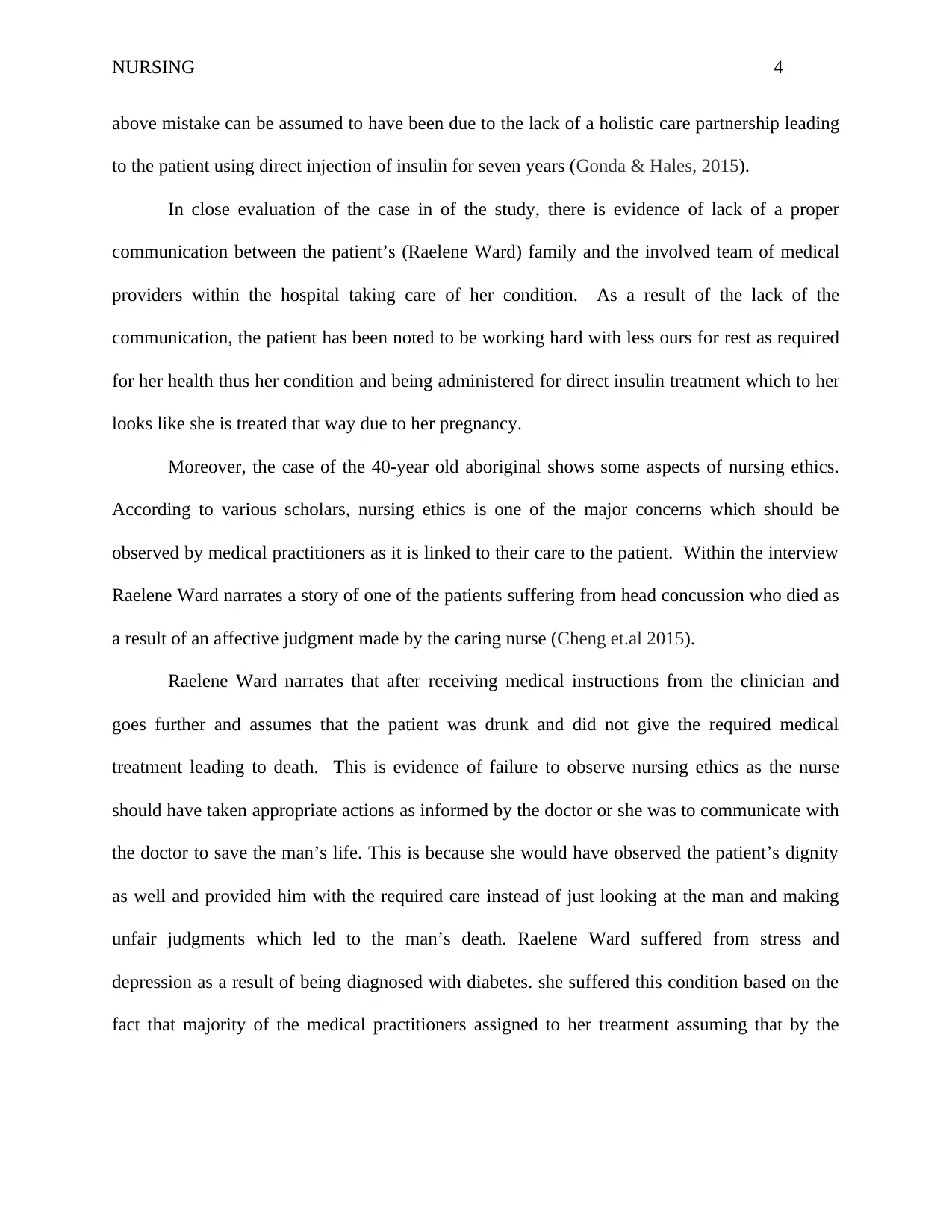
NURSING 4
above mistake can be assumed to have been due to the lack of a holistic care partnership leading
to the patient using direct injection of insulin for seven years (Gonda & Hales, 2015).
In close evaluation of the case in of the study, there is evidence of lack of a proper
communication between the patient’s (Raelene Ward) family and the involved team of medical
providers within the hospital taking care of her condition. As a result of the lack of the
communication, the patient has been noted to be working hard with less ours for rest as required
for her health thus her condition and being administered for direct insulin treatment which to her
looks like she is treated that way due to her pregnancy.
Moreover, the case of the 40-year old aboriginal shows some aspects of nursing ethics.
According to various scholars, nursing ethics is one of the major concerns which should be
observed by medical practitioners as it is linked to their care to the patient. Within the interview
Raelene Ward narrates a story of one of the patients suffering from head concussion who died as
a result of an affective judgment made by the caring nurse (Cheng et.al 2015).
Raelene Ward narrates that after receiving medical instructions from the clinician and
goes further and assumes that the patient was drunk and did not give the required medical
treatment leading to death. This is evidence of failure to observe nursing ethics as the nurse
should have taken appropriate actions as informed by the doctor or she was to communicate with
the doctor to save the man’s life. This is because she would have observed the patient’s dignity
as well and provided him with the required care instead of just looking at the man and making
unfair judgments which led to the man’s death. Raelene Ward suffered from stress and
depression as a result of being diagnosed with diabetes. she suffered this condition based on the
fact that majority of the medical practitioners assigned to her treatment assuming that by the
above mistake can be assumed to have been due to the lack of a holistic care partnership leading
to the patient using direct injection of insulin for seven years (Gonda & Hales, 2015).
In close evaluation of the case in of the study, there is evidence of lack of a proper
communication between the patient’s (Raelene Ward) family and the involved team of medical
providers within the hospital taking care of her condition. As a result of the lack of the
communication, the patient has been noted to be working hard with less ours for rest as required
for her health thus her condition and being administered for direct insulin treatment which to her
looks like she is treated that way due to her pregnancy.
Moreover, the case of the 40-year old aboriginal shows some aspects of nursing ethics.
According to various scholars, nursing ethics is one of the major concerns which should be
observed by medical practitioners as it is linked to their care to the patient. Within the interview
Raelene Ward narrates a story of one of the patients suffering from head concussion who died as
a result of an affective judgment made by the caring nurse (Cheng et.al 2015).
Raelene Ward narrates that after receiving medical instructions from the clinician and
goes further and assumes that the patient was drunk and did not give the required medical
treatment leading to death. This is evidence of failure to observe nursing ethics as the nurse
should have taken appropriate actions as informed by the doctor or she was to communicate with
the doctor to save the man’s life. This is because she would have observed the patient’s dignity
as well and provided him with the required care instead of just looking at the man and making
unfair judgments which led to the man’s death. Raelene Ward suffered from stress and
depression as a result of being diagnosed with diabetes. she suffered this condition based on the
fact that majority of the medical practitioners assigned to her treatment assuming that by the
Secure Best Marks with AI Grader
Need help grading? Try our AI Grader for instant feedback on your assignments.
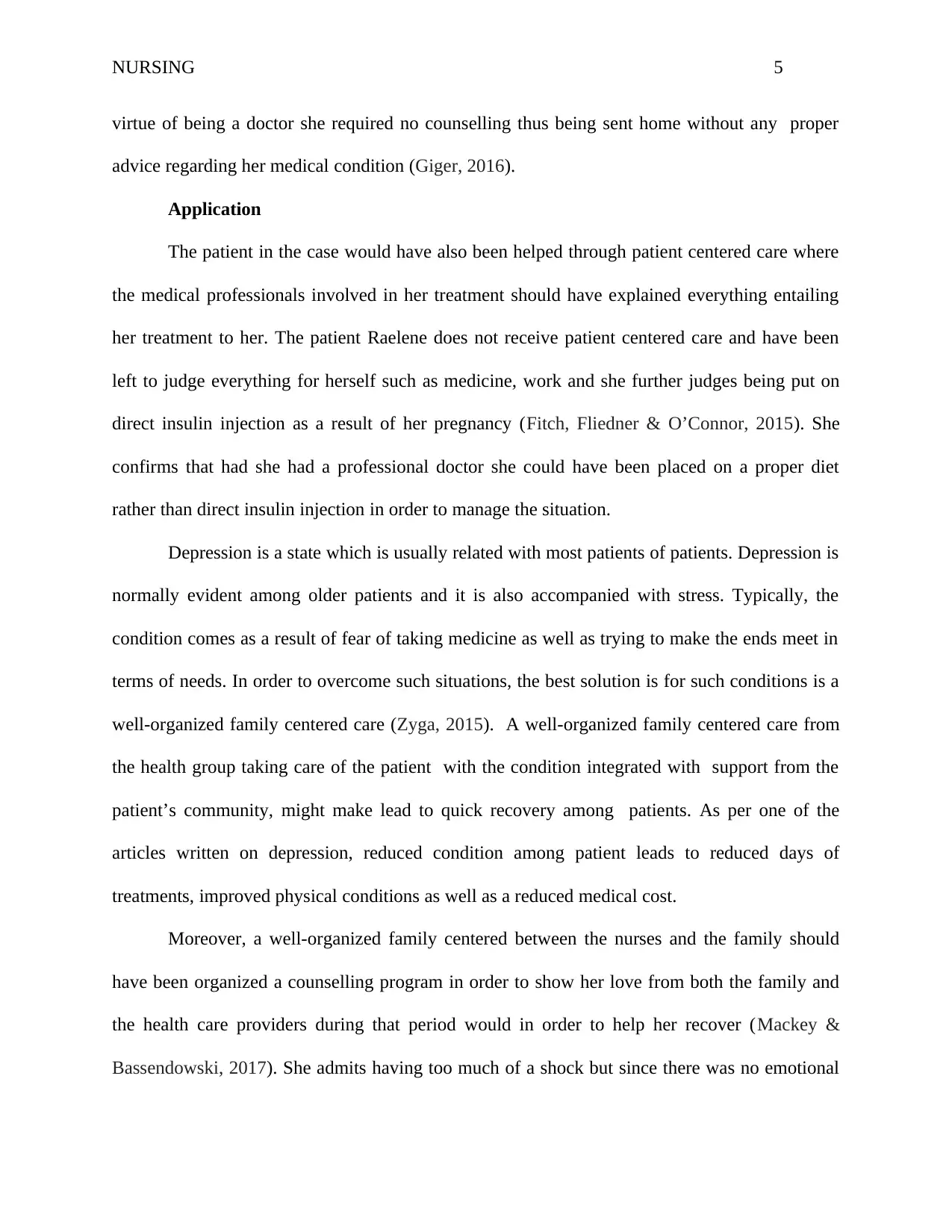
NURSING 5
virtue of being a doctor she required no counselling thus being sent home without any proper
advice regarding her medical condition (Giger, 2016).
Application
The patient in the case would have also been helped through patient centered care where
the medical professionals involved in her treatment should have explained everything entailing
her treatment to her. The patient Raelene does not receive patient centered care and have been
left to judge everything for herself such as medicine, work and she further judges being put on
direct insulin injection as a result of her pregnancy (Fitch, Fliedner & O’Connor, 2015). She
confirms that had she had a professional doctor she could have been placed on a proper diet
rather than direct insulin injection in order to manage the situation.
Depression is a state which is usually related with most patients of patients. Depression is
normally evident among older patients and it is also accompanied with stress. Typically, the
condition comes as a result of fear of taking medicine as well as trying to make the ends meet in
terms of needs. In order to overcome such situations, the best solution is for such conditions is a
well-organized family centered care (Zyga, 2015). A well-organized family centered care from
the health group taking care of the patient with the condition integrated with support from the
patient’s community, might make lead to quick recovery among patients. As per one of the
articles written on depression, reduced condition among patient leads to reduced days of
treatments, improved physical conditions as well as a reduced medical cost.
Moreover, a well-organized family centered between the nurses and the family should
have been organized a counselling program in order to show her love from both the family and
the health care providers during that period would in order to help her recover (Mackey &
Bassendowski, 2017). She admits having too much of a shock but since there was no emotional
virtue of being a doctor she required no counselling thus being sent home without any proper
advice regarding her medical condition (Giger, 2016).
Application
The patient in the case would have also been helped through patient centered care where
the medical professionals involved in her treatment should have explained everything entailing
her treatment to her. The patient Raelene does not receive patient centered care and have been
left to judge everything for herself such as medicine, work and she further judges being put on
direct insulin injection as a result of her pregnancy (Fitch, Fliedner & O’Connor, 2015). She
confirms that had she had a professional doctor she could have been placed on a proper diet
rather than direct insulin injection in order to manage the situation.
Depression is a state which is usually related with most patients of patients. Depression is
normally evident among older patients and it is also accompanied with stress. Typically, the
condition comes as a result of fear of taking medicine as well as trying to make the ends meet in
terms of needs. In order to overcome such situations, the best solution is for such conditions is a
well-organized family centered care (Zyga, 2015). A well-organized family centered care from
the health group taking care of the patient with the condition integrated with support from the
patient’s community, might make lead to quick recovery among patients. As per one of the
articles written on depression, reduced condition among patient leads to reduced days of
treatments, improved physical conditions as well as a reduced medical cost.
Moreover, a well-organized family centered between the nurses and the family should
have been organized a counselling program in order to show her love from both the family and
the health care providers during that period would in order to help her recover (Mackey &
Bassendowski, 2017). She admits having too much of a shock but since there was no emotional
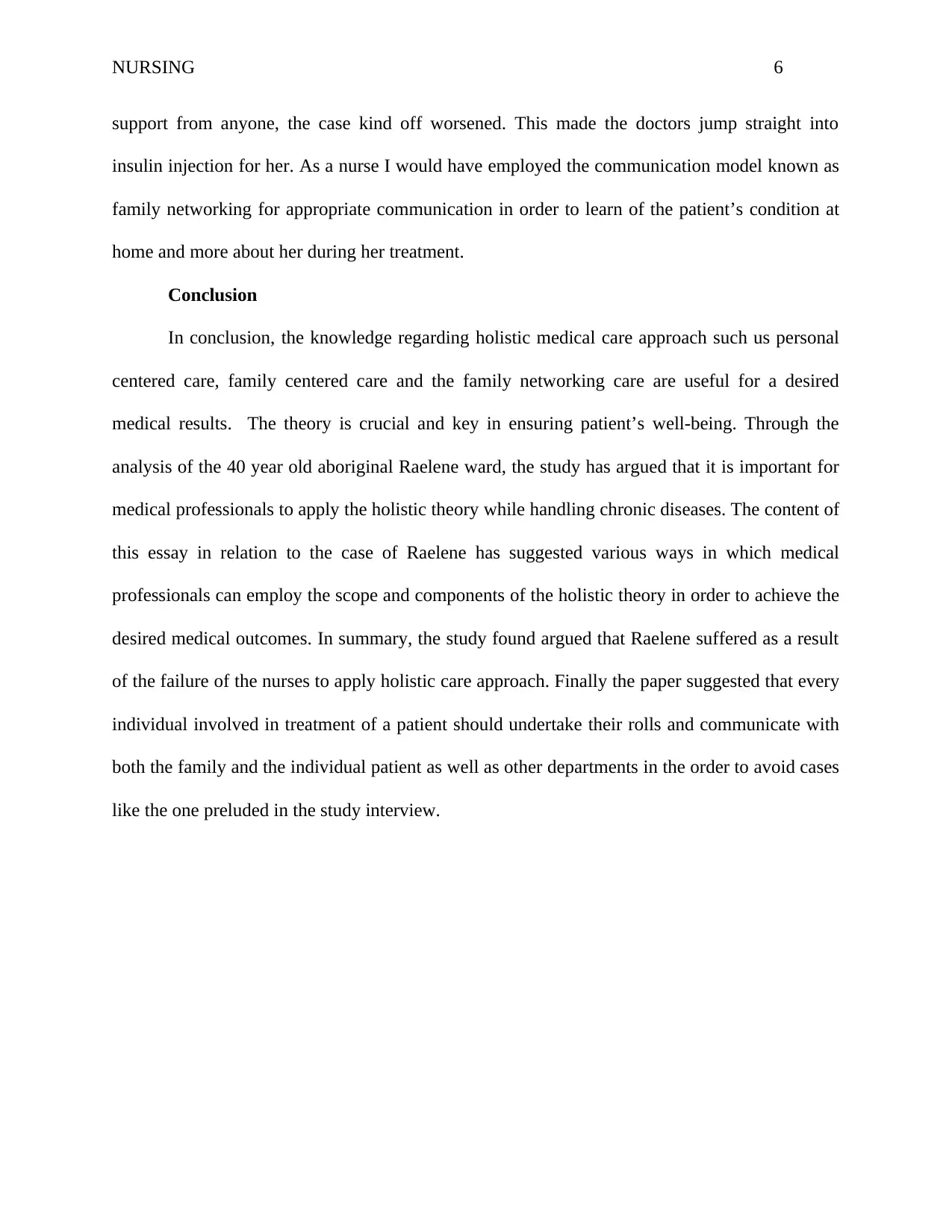
NURSING 6
support from anyone, the case kind off worsened. This made the doctors jump straight into
insulin injection for her. As a nurse I would have employed the communication model known as
family networking for appropriate communication in order to learn of the patient’s condition at
home and more about her during her treatment.
Conclusion
In conclusion, the knowledge regarding holistic medical care approach such us personal
centered care, family centered care and the family networking care are useful for a desired
medical results. The theory is crucial and key in ensuring patient’s well-being. Through the
analysis of the 40 year old aboriginal Raelene ward, the study has argued that it is important for
medical professionals to apply the holistic theory while handling chronic diseases. The content of
this essay in relation to the case of Raelene has suggested various ways in which medical
professionals can employ the scope and components of the holistic theory in order to achieve the
desired medical outcomes. In summary, the study found argued that Raelene suffered as a result
of the failure of the nurses to apply holistic care approach. Finally the paper suggested that every
individual involved in treatment of a patient should undertake their rolls and communicate with
both the family and the individual patient as well as other departments in the order to avoid cases
like the one preluded in the study interview.
support from anyone, the case kind off worsened. This made the doctors jump straight into
insulin injection for her. As a nurse I would have employed the communication model known as
family networking for appropriate communication in order to learn of the patient’s condition at
home and more about her during her treatment.
Conclusion
In conclusion, the knowledge regarding holistic medical care approach such us personal
centered care, family centered care and the family networking care are useful for a desired
medical results. The theory is crucial and key in ensuring patient’s well-being. Through the
analysis of the 40 year old aboriginal Raelene ward, the study has argued that it is important for
medical professionals to apply the holistic theory while handling chronic diseases. The content of
this essay in relation to the case of Raelene has suggested various ways in which medical
professionals can employ the scope and components of the holistic theory in order to achieve the
desired medical outcomes. In summary, the study found argued that Raelene suffered as a result
of the failure of the nurses to apply holistic care approach. Finally the paper suggested that every
individual involved in treatment of a patient should undertake their rolls and communicate with
both the family and the individual patient as well as other departments in the order to avoid cases
like the one preluded in the study interview.
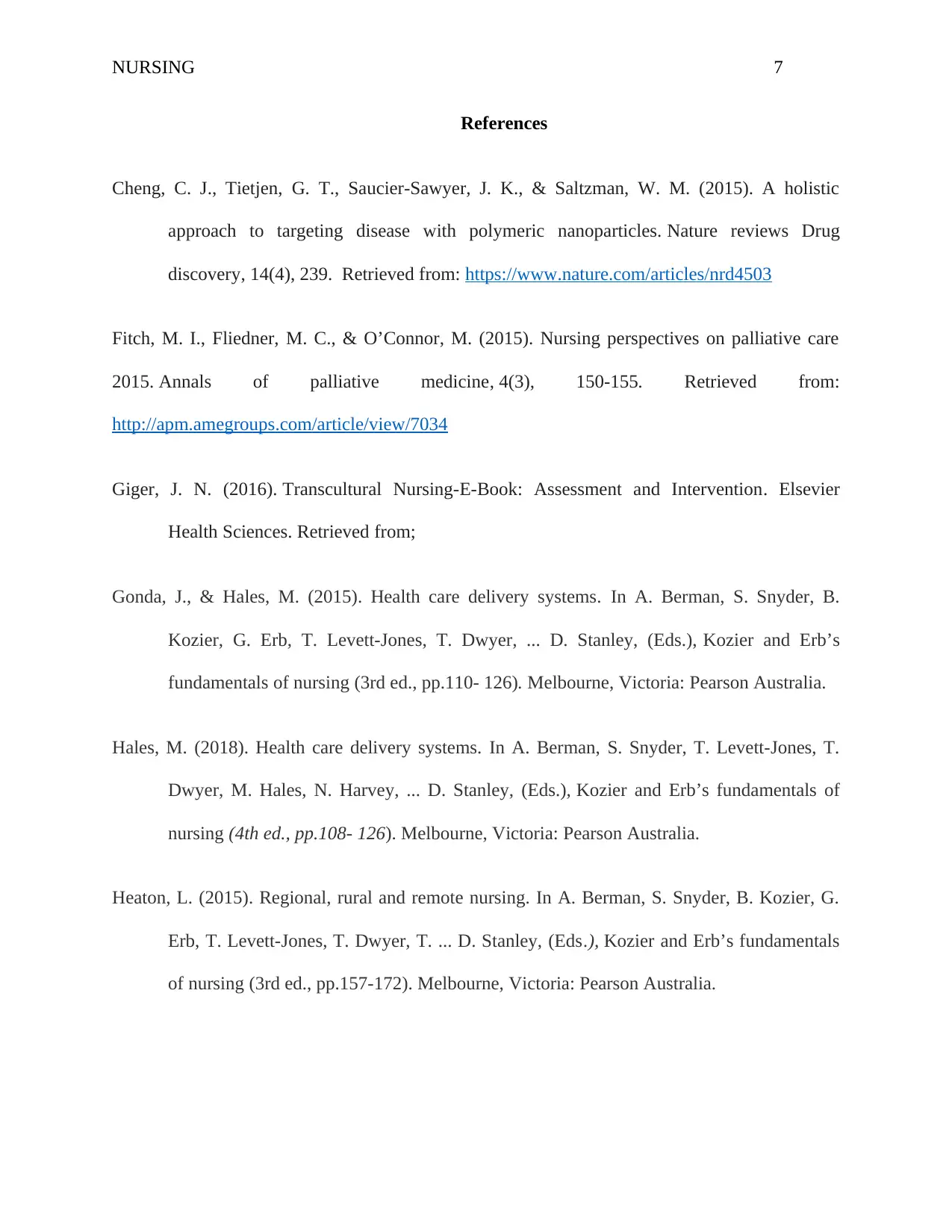
NURSING 7
References
Cheng, C. J., Tietjen, G. T., Saucier-Sawyer, J. K., & Saltzman, W. M. (2015). A holistic
approach to targeting disease with polymeric nanoparticles. Nature reviews Drug
discovery, 14(4), 239. Retrieved from: https://www.nature.com/articles/nrd4503
Fitch, M. I., Fliedner, M. C., & O’Connor, M. (2015). Nursing perspectives on palliative care
2015. Annals of palliative medicine, 4(3), 150-155. Retrieved from:
http://apm.amegroups.com/article/view/7034
Giger, J. N. (2016). Transcultural Nursing-E-Book: Assessment and Intervention. Elsevier
Health Sciences. Retrieved from;
Gonda, J., & Hales, M. (2015). Health care delivery systems. In A. Berman, S. Snyder, B.
Kozier, G. Erb, T. Levett-Jones, T. Dwyer, ... D. Stanley, (Eds.), Kozier and Erb’s
fundamentals of nursing (3rd ed., pp.110- 126). Melbourne, Victoria: Pearson Australia.
Hales, M. (2018). Health care delivery systems. In A. Berman, S. Snyder, T. Levett-Jones, T.
Dwyer, M. Hales, N. Harvey, ... D. Stanley, (Eds.), Kozier and Erb’s fundamentals of
nursing (4th ed., pp.108- 126). Melbourne, Victoria: Pearson Australia.
Heaton, L. (2015). Regional, rural and remote nursing. In A. Berman, S. Snyder, B. Kozier, G.
Erb, T. Levett-Jones, T. Dwyer, T. ... D. Stanley, (Eds.), Kozier and Erb’s fundamentals
of nursing (3rd ed., pp.157-172). Melbourne, Victoria: Pearson Australia.
References
Cheng, C. J., Tietjen, G. T., Saucier-Sawyer, J. K., & Saltzman, W. M. (2015). A holistic
approach to targeting disease with polymeric nanoparticles. Nature reviews Drug
discovery, 14(4), 239. Retrieved from: https://www.nature.com/articles/nrd4503
Fitch, M. I., Fliedner, M. C., & O’Connor, M. (2015). Nursing perspectives on palliative care
2015. Annals of palliative medicine, 4(3), 150-155. Retrieved from:
http://apm.amegroups.com/article/view/7034
Giger, J. N. (2016). Transcultural Nursing-E-Book: Assessment and Intervention. Elsevier
Health Sciences. Retrieved from;
Gonda, J., & Hales, M. (2015). Health care delivery systems. In A. Berman, S. Snyder, B.
Kozier, G. Erb, T. Levett-Jones, T. Dwyer, ... D. Stanley, (Eds.), Kozier and Erb’s
fundamentals of nursing (3rd ed., pp.110- 126). Melbourne, Victoria: Pearson Australia.
Hales, M. (2018). Health care delivery systems. In A. Berman, S. Snyder, T. Levett-Jones, T.
Dwyer, M. Hales, N. Harvey, ... D. Stanley, (Eds.), Kozier and Erb’s fundamentals of
nursing (4th ed., pp.108- 126). Melbourne, Victoria: Pearson Australia.
Heaton, L. (2015). Regional, rural and remote nursing. In A. Berman, S. Snyder, B. Kozier, G.
Erb, T. Levett-Jones, T. Dwyer, T. ... D. Stanley, (Eds.), Kozier and Erb’s fundamentals
of nursing (3rd ed., pp.157-172). Melbourne, Victoria: Pearson Australia.
Paraphrase This Document
Need a fresh take? Get an instant paraphrase of this document with our AI Paraphraser
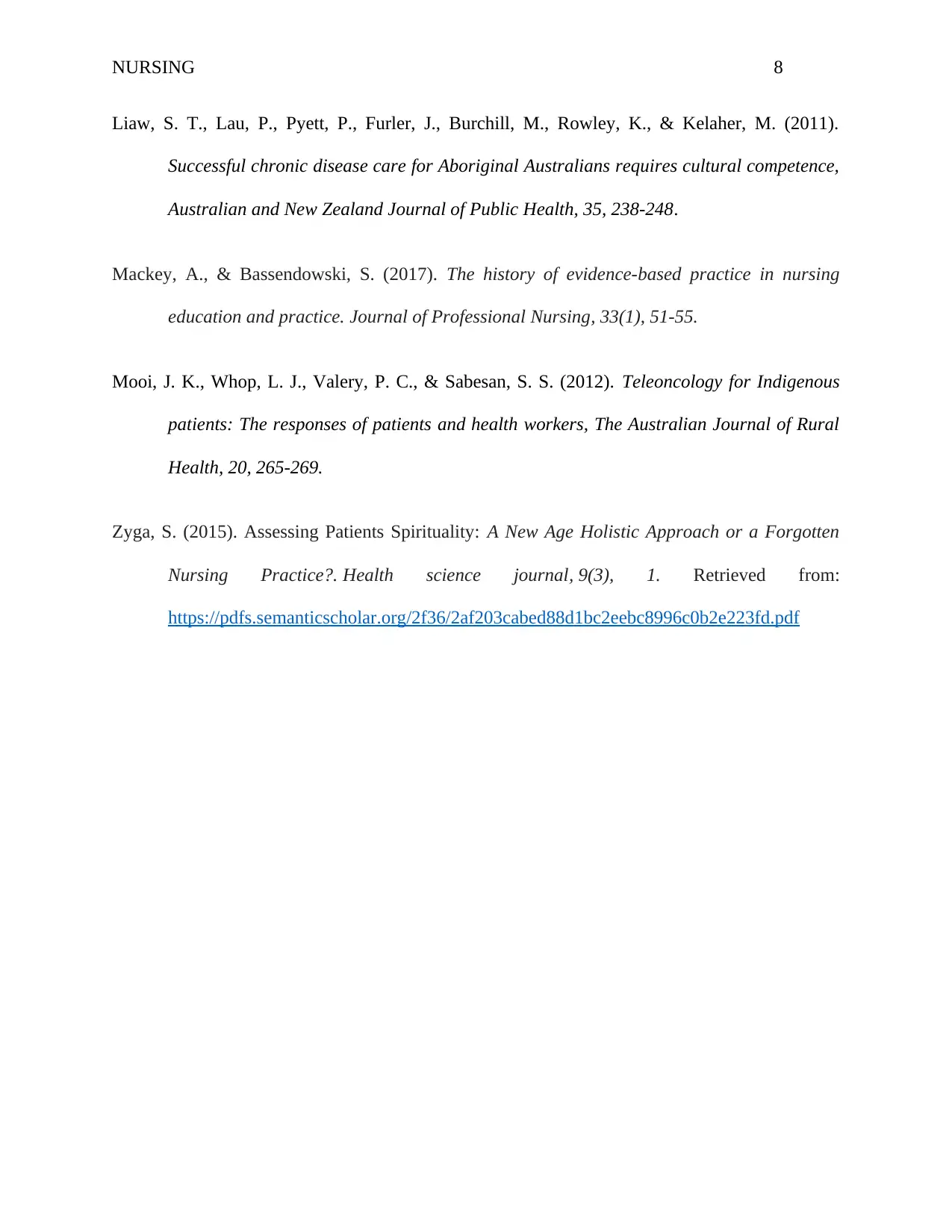
NURSING 8
Liaw, S. T., Lau, P., Pyett, P., Furler, J., Burchill, M., Rowley, K., & Kelaher, M. (2011).
Successful chronic disease care for Aboriginal Australians requires cultural competence,
Australian and New Zealand Journal of Public Health, 35, 238-248.
Mackey, A., & Bassendowski, S. (2017). The history of evidence-based practice in nursing
education and practice. Journal of Professional Nursing, 33(1), 51-55.
Mooi, J. K., Whop, L. J., Valery, P. C., & Sabesan, S. S. (2012). Teleoncology for Indigenous
patients: The responses of patients and health workers, The Australian Journal of Rural
Health, 20, 265-269.
Zyga, S. (2015). Assessing Patients Spirituality: A New Age Holistic Approach or a Forgotten
Nursing Practice?. Health science journal, 9(3), 1. Retrieved from:
https://pdfs.semanticscholar.org/2f36/2af203cabed88d1bc2eebc8996c0b2e223fd.pdf
Liaw, S. T., Lau, P., Pyett, P., Furler, J., Burchill, M., Rowley, K., & Kelaher, M. (2011).
Successful chronic disease care for Aboriginal Australians requires cultural competence,
Australian and New Zealand Journal of Public Health, 35, 238-248.
Mackey, A., & Bassendowski, S. (2017). The history of evidence-based practice in nursing
education and practice. Journal of Professional Nursing, 33(1), 51-55.
Mooi, J. K., Whop, L. J., Valery, P. C., & Sabesan, S. S. (2012). Teleoncology for Indigenous
patients: The responses of patients and health workers, The Australian Journal of Rural
Health, 20, 265-269.
Zyga, S. (2015). Assessing Patients Spirituality: A New Age Holistic Approach or a Forgotten
Nursing Practice?. Health science journal, 9(3), 1. Retrieved from:
https://pdfs.semanticscholar.org/2f36/2af203cabed88d1bc2eebc8996c0b2e223fd.pdf
1 out of 8
Related Documents
Your All-in-One AI-Powered Toolkit for Academic Success.
+13062052269
info@desklib.com
Available 24*7 on WhatsApp / Email
![[object Object]](/_next/static/media/star-bottom.7253800d.svg)
Unlock your academic potential
© 2024 | Zucol Services PVT LTD | All rights reserved.




